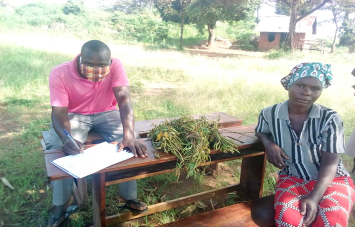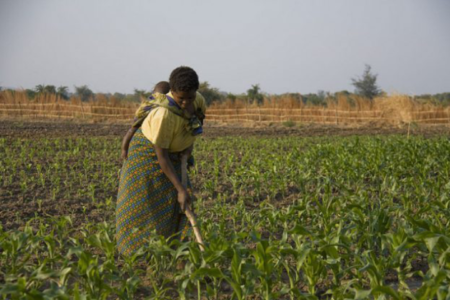Building back better
The ongoing pandemic is rapidly evolving into multifaceted crises as economies shut down and unemployment accelerates. Estimates put the global fall in GDP at 5%, nearly 9% in Africa, and rises in poverty of 140 million more people, almost exclusively in Africa and South Asia. Many farmers have been unable to get their produce to urban markets, and access to agricultural inputs, technical support and essential services may soon dry up. With economic slowdown comes income reductions, rising unemployment and falling purchasing power.
Even as domestic restrictions are eased, food export economies may feel compelled to impose restrictions on the trade of essential foods, leading to potential damaging rises in the prices of staple crops, particularly wheat and rice. Recent experience of food crises suggests that the numbers at risk of or experiencing acute food insecurity, currently 318 million people, will rise significantly.
The third and sixth most important food crops globally, potato and sweetpotato offer significant opportunities to help developing countries build resilience of their food systems in the face of economic and food security shocks. Experience in countries like Ethiopia, Malawi and Mozambique suggests that sweetpotato production offers smallholder farmers viable strategies to rapidly ramping up food production for their families. Moreover, the long-term expansion of potato and sweetpotato production can help stabilize volatile food systems and generate employment and a market for healthy foods in urban areas.
As supply chains are disrupted in Ethiopia and Mozambique, calibrated interventions will be needed to support the functioning of seed systems, ensuring by vulnerable populations to nutritious food and buffering falls in farm incomes. If production is to be ramped up, farmers will need access to sufficient amounts of high-quality inputs and agronomic support. Ensuring food reaches the most vulnerable populations will rely on the consolidation of targeted food distribution channels with partner organizations. Protecting the most vulnerable will involve supporting experienced national and international partners to prioritize food distribution for humanitarian and social safety net programs.
International Potato Center (CIP) teams have been working on redirecting our portfolio, where appropriate, to meet the needs of resource-constrained populations in Africa, Asia and Latin America affected by COVID-19. As part of the One CGIAR response, our scientists are working on putting together comprehensive analysis of the needs of farmers, value chain actors and consumers to get a clear understanding of the impacts of the crisis on food systems in major developing countries.
Our strategic response relies on CIP’s proven experience in responding to humanitarian crises, rapid upscaling of tested technologies and building resilience in impacted communities. Working closely with networks of partners, these broad-based global interventions will be adapted to meet to specific local needs:
- Rapid, mass multiplication and distribution of quality planting material of appropriate potato and sweetpotato varieties, prioritizing the deployment of biofortified varieties, helping rebuild sustainable seed and production systems to reach prioritized vulnerable populations, such as refugee camps, hospitals.
- Expansion of e-extension and e-training for extension agents and farmers to support improved crop management
- Policy advice to national governments and regional intergovernmental organizations on integrating potato and sweetpotato, as highly nutritious crops, into interventions to support food systems recovery and build long-term resilience.
- Expansion of horticulture supply chains targeting vulnerable populations, particularly in relation to food storage, processing and retail capacity.
Key messages
- The COVID-19 pandemic – itself likely to have originated from the food system – is exposing gaps and exploiting weaknesses in food systems, societies and economies around the world.
- The health risks of the pandemic, combined with the social and economic impacts of measures to stop the spread of the disease are posing threats to food, nutrition and water security, as well as continued progress on achieving global goals to end poverty and hunger, especially in low- and middle-income countries.
- Without substantial emergency relief, 140 million people could fall into extreme poverty, potentially increasing hunger and malnutrition for millions. The world’s most vulnerable—including women, young people, small-scale farmers and the urban poor—will be the hardest hit.
- The global response to the pandemic must be swift and science-based, harnessing knowledge for emergency response, recovery, and resilience.
- CIP, a member of the world’s largest public agricultural research network, CGIAR, has a strong portfolio of research-for-development interventions and partnerships to respond to the food, income and nutrition consequences of the pandemic.
- CIP is actively sharing its existing and emerging knowledge and experience to help address the specific challenges posed by COVID-19, and to rapidly inform policy and programmatic responses.
- The core of CIP’s response is based on four key pillars, in close collaboration with the CGIAR: Rapid, mass multiplication and distribution of quality planting material; Expansion of e-extension and e-training; targeted policy advice for governments; and expansion of horticulture supply chains targeting vulnerable populations.
- Building back better—not returning to business as usual following the COVID-19 crisis—is a priority for CIP and the CGIAR as a whole in its efforts to transform food systems to reduce poverty, improve food and nutrition security, and improve the quality of natural resources and ecosystem services, in line with global goals on sustainable development and climate change



